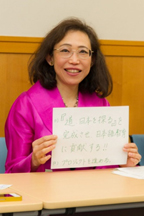

 My sabbatical at the Japan Foundation's Japanese Language Institute in Urawa by Noriko Nagata
My sabbatical at the Japan Foundation's Japanese Language Institute in Urawa by Noriko Nagata
University of San Francisco
San Francisco, California
I am Professor and Director of the Japanese Studies Program at the University of San Francisco. I teach Japanese language, linguistics, and culture. From October 23rd through December 19th in 2013, I participated in the Japan Foundation’s Advanced Training Program for Teachers of Japanese at the Japanese Language Institute in Urawa, Japan. The program provided an excellent opportunity to pursue my Japanese textbook project. I truly appreciate the dedication and hard work the Japan Foundation staff, instructors, and participants put into this very successful program.
My textbook, entitled『道:日本を探る』“The Path: Exploring Japan,” teaches the Japanese language through the lens of the rich variety of cultural landscapes in historical and contemporary Japan. I visited fifty-three major cities throughout Japan during the past five years and captured over fifty thousand photographic and video images for the new textbook. The textbook aims to develop learners’ Japanese language proficiency to the intermediate and advanced levels, based on the ACTFL and JF standards. The textbook will incorporate innovative, online exercises in which learners can practice sentence production and receive detailed feedback in response to their grammatical errors, provided by natural language processing technology developed by the author. The online exercise program will be an expanded version of ROBO-SENSEI: Personal Japanese Tutor (Nagata 2004), published by Cheng & Tsui.
 One of the distinctive features of the Japan Foundation program was an individual meeting with a program instructor about my project once or twice per week. Kijima-sensei was the program instructor associated with my project. I received detailed comments from her on the content of the ten chapters I had created so far. I also had a wide range of very helpful discussions with her related to the textbook’s development, including teaching philosophy, chapter components, cultural images, exercise materials, the publishing process, and so forth. During the course of the program, the participants delivered initial project presentations, mid-way reports, and final presentations. They received useful comments from one another and from program instructors. The book is an ongoing project for me, but my experience at the Japan Foundation has given me momentum toward its completion (photograph).
One of the distinctive features of the Japan Foundation program was an individual meeting with a program instructor about my project once or twice per week. Kijima-sensei was the program instructor associated with my project. I received detailed comments from her on the content of the ten chapters I had created so far. I also had a wide range of very helpful discussions with her related to the textbook’s development, including teaching philosophy, chapter components, cultural images, exercise materials, the publishing process, and so forth. During the course of the program, the participants delivered initial project presentations, mid-way reports, and final presentations. They received useful comments from one another and from program instructors. The book is an ongoing project for me, but my experience at the Japan Foundation has given me momentum toward its completion (photograph).
 In addition to our individual research projects, participants attended a number of lectures about teaching method, material analysis, course design, and learning assessment. We also had group discussions, which were fruitful and constructive. In particular, we learned about the Japan Foundation’s new standards and Can-do activities in detail. We are now looking for ways to integrate Can-do activities into our projects.
In addition to our individual research projects, participants attended a number of lectures about teaching method, material analysis, course design, and learning assessment. We also had group discussions, which were fruitful and constructive. In particular, we learned about the Japan Foundation’s new standards and Can-do activities in detail. We are now looking for ways to integrate Can-do activities into our projects.

I had a great time with the other ten participants in my group, who came from a very diverse range of locations (Argentina, Cuba, Holland, Jordan, Madagascar, Myanmar, Russia, Singapore, U.S.A.) We attended every session together and enjoyed many conversations and jokes in Japanese during our joint meals in the institute’s cafeteria. We went on a memorable Tokyo field trip arranged by the program, in which we learned how to make plastic cabbage and tempura food models of the sort displayed by Japanese restaurants (photograph). We also visited the Japanese parliament building (photograph), and enjoyed spectacular Tokyo views from the Roppongi Hills (photograph).
 My program was only one of many. Japanese language educators from a total of thirty-five countries were participating in different programs at the institute during my stay. I was stimulated by their positive attitude toward Japan and by the discussions I had with them about their home countries. It was inspiring to meet so many skilled Japanese educators from around the world. The spread of Japanese language education is vital in our increasingly global society. The Japan Foundation is playing a central role.
My program was only one of many. Japanese language educators from a total of thirty-five countries were participating in different programs at the institute during my stay. I was stimulated by their positive attitude toward Japan and by the discussions I had with them about their home countries. It was inspiring to meet so many skilled Japanese educators from around the world. The spread of Japanese language education is vital in our increasingly global society. The Japan Foundation is playing a central role.